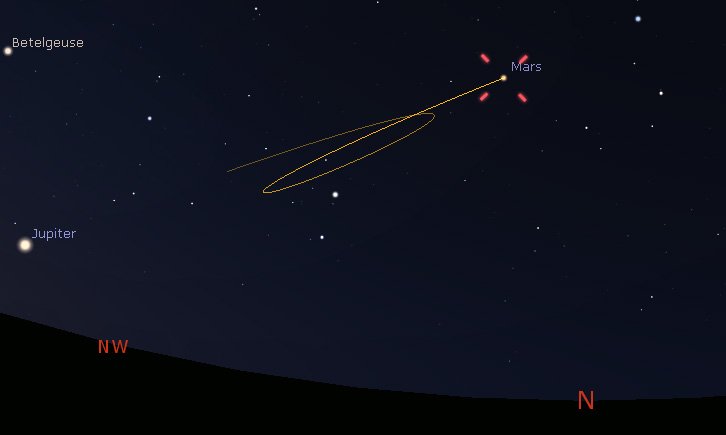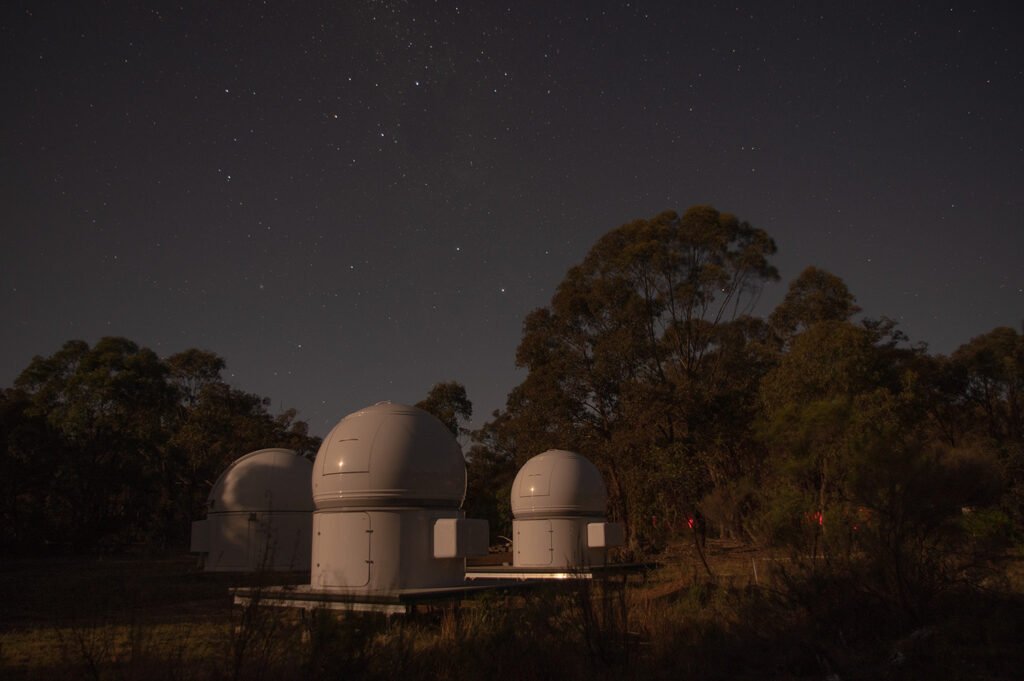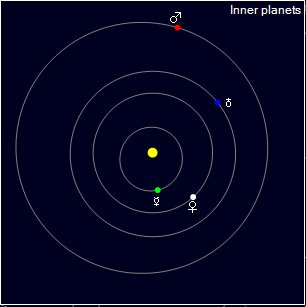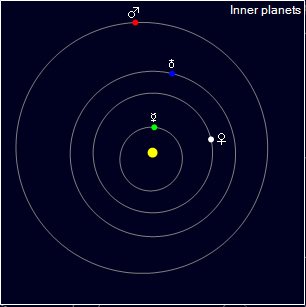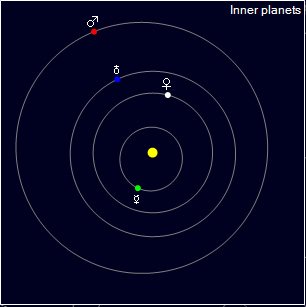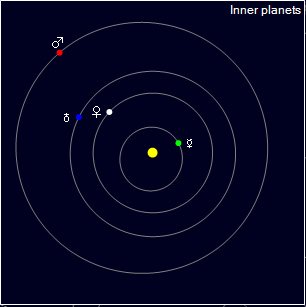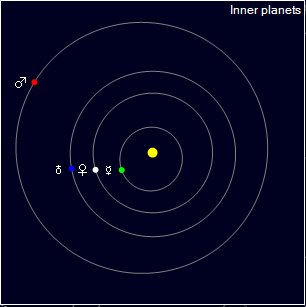Every month, I present a talk at the Astronomical Society of Victoria on what’s up in the sky. They’re uploaded to YouTube and a few other video sites, and I talk about what visual observers can see at this time of year, what astrophotographers can image, as well as other things. One of the regular segments is about the planets. I normally talk about rising or setting times, but I also mention when a planet starts or ends its retrograde cycle.
So, a common question after that is “what’s retrograde”? Well, it’s when a planet does this…
Planets change position against the stars
As you will know, the Earth spins on its axis, and if you stand on one spot on the Earth, the part of the sky you see rotates throughout the night. This is what gives us sunrise and sunset, and it’s why the stars seem to move throughout the night.
We now know that all planets, including the Earth, all move around the sun in their various orbits. We haven’t known this forever, of course, and figuring out what was happening was a long and at times painful enlightenment. When you watch a planet over a period of weeks, you’ll notice it moves against the background stars as it (and the Earth) progresses in its orbit.
But it’s a bit more complicated than that. The planets don’t always go in the same direction. Most of the time, planets move a bit slower than the background stars, so it looks as though they are falling behind. But sometimes they speed up, overtaking the stars. While they’re doing this, they also get brighter. And all this caused all sorts of consternation for the astrologers. They called it “retrograde”, or “moving backwards”.
What retrograde isn’t
In short, “retrograde” is when the planet appears to speed up, overtaking the stars behind it. This is a visual effect resulting from our point of view changing. We’re on the Earth, looking towards another planet, and both are in motion. However, if you look up “retrograde” on the Internet, especially when paired with the name of a planet… oh boy.
No, the change in the background stars when we look at a different planet over time cannot tell the future. It cannot explain why people act in a certain way, and it cannot determine whether it’s a good idea to pursue one path or another. It absolutely cannot determine whether your lucky numbers will come up in Tattslotto, or whether a particular horse will win the Melbourne Cup.
A bit more detail
Watching on one night
I know you’ve watched stars overnight. You wouldn’t be reading this it you hadn’t. Up at our Astronomical Society’s dark sky site, we get the beautiful sight of the stars coming into view over the domes to the east of the field, moving up (and slightly to the left, because we’re in the Southern Hemisphere), and reaching the meridian, their highest place. From there they keep moving toward the west at about 15° per hour. They eventually disappear into the trees around the radio telescope. On just one night, if there’s a planet in view, it doesn’t move much differently to the stars. If you’re watching very closely with a telescope you might notice it moving very slightly.
Watching over a month
I normally go to the dark sky site a couple of times a month, meaning I can see the sky and how it changes from week to week. If I look in the same direction at the same time a few weeks apart I will see that the same stars have moved towards the west compared with last time I looked. This is because the Earth moves around the Sun in its orbit – it’s actually because the sun is changing its position against the background stars. I’d encourage you to simulate this in a planetarium program like Stellarium.
But what about the planets? Well, they generally move to the west as well, but because they’re moving a smidge slower than the stars, they appear to fall behind. Some people call this “moving towards the east”, and I understand what they mean by this. However, because the planets are demonstrably moving towards the west, I find this plain confusing. I’ll just leave it that the planets are generally falling behind. You can simulate this in Stellarium as well.
But I say generally because the planets don’t always fall behind, as I mentioned before.
Oops, had the silly thing in reverse
At one part of their orbit, planets, most noticeably the “superior” planets further from the Sun, move a bit faster than the stars. Over the period of weeks, you’ll see they have moved ahead. They rise earlier than the stars around them did a few weeks ago, pass the meridian earlier, and set earlier. This is called “retrograde motion” and again, you can simulate this in Stellarium. Probably the best planet to look at is Mars, because the retrograde effect is the largest.
At the top of this article, you’ll see a screenshot from Stellarium showing how Mars moved against the background stars between October 2024 (before its last retrograde began) and April 2025 (after retrograde ended). You can see that Mars moved towards the west slower than the stars (seeming to move to the right, or east). But then it stopped and for a period it moved faster than the stars (appearing to move to the left). However, after another while it began to fall behind again.
The phases of the orbits
You can think of the wiggly line above as five stages in the relationship between the Earth and Mars. The diagrams below show what the Earth and Mars were doing at each of these stages. Mars is the red dot on the outside of the maps, and the Earth is the blue dot one orbit inside Mars’. The planets are all moving anticlockwise in these maps. The Sun is the yellow dot in the middle. (These maps are from https://www.heavens-above.com/planets.aspx)
Prograde
First, in October 2024, when Mars was way back on the left of the map above, we were in “prograde”, or normal motion. At this point, visually, the Earth was moving towards Mars while Mars was moving towards the left. Against the stars, therefore, Mars will have appeared to be moving to the left.
Stationary
On 8 December 2024, we were in this position. The Earth had started to curve inwards in its orbit, and at that point it was moving directly towards Mars. This just cancelled Mars’ apparent motion to the left, making it look like Mars had stopped entirely. This is the beginning of retrograde motion, and after this, Mars started to move to the right.
Opposition
This was the situation on the 16th of January 2025. On that day, we’re still in retrograde, but Mars, the Earth and the Sun are in a straight line, a point known as opposition. This is the point at which Mars is closest to the Earth, and this is why Mars will have been brightest to viewers on the Earth.
Incidentally, this is also about the best time for spacecraft to travel between the planets.
Stationary again
This is the second stationary point – 23 February 2025. On that night, the Earth was moving directly away from Mars, so Mars stops moving to the right and begins moving to the left again. This is when retrograde ceases.
The final map is a return to the first situation, or “prograde” motion.
What does this all tell us?
Astronomers (and previously astrologers) have been looking at the night sky forever. The idea that what was up there was trying to communicate something to us, or that what we saw there had any meaning at all was compelling. It’s human nature to want to understand our environment, and this is another aspect of that.
Retrograde motion caused the astrologers massive headaches when they were trying to understand how the solar system worked. Their models and their understanding changed and developed over time, but they just weren’t able to figure out what was going on. They’d develop an approximate solution, but inevitably more accurate observations would show that they weren’t quite right.
As time went on, demands on astrologers for more and deeper understanding of heavenly meaning led to greater and greater accuracy of the positions of the planets. Tycho Brahe’s enormous machines were the pinnacle of that line of development. The data they produced allowed Johannes Kepler to propose that Mars travelled in an ellipse. Probably more than any other discovery, that moment marked the birth of modern astronomy.
Even with our current understanding of gravity, mass, orbits, and the various laws of orbital motion, it took until Einstein’s theory of Relativity to give us a comprehensive understanding of what Mercury was doing.
But perhaps we’re not there even now.
So how do I see a planet?
Now you’ve got this far, I’m hoping you’re wondering how you can see planets move as well. First, you’re going to have to watch the sky every week or two for a few months before you can detect any significant movement. You’ll also have to know which of those dots out there are the planets. There are phone apps for that, such as Stellarium, StarWalk2 or Sky Safari.
Once you’ve figured out which one is Mars, Saturn, Jupiter or Venus (these are the easiest planets to see), make a mental note of its position. You might like to make an actual note, or even take a phone photo. Yes, you can do this! Wait a week or two, then have another look. (If you’re in Melbourne it’ll probably be that long before you get a clear sky again!) You’ll probably notice that the planet has moved.
Use a telescope?
If you want to be really sure that what you’re seeing is what you think it is, you’ll need a lot of magnification. A telescope with about 900mm or more of focal length will do the job. They’re not expensive, and our recommendation for a decent start is the saxon 909AZ3. Beware, though, there are “hobby killers” out there that won’t give you a decent look. This scope will allow you to identify the planet with absolute confidence. Saturn has its rings, and Jupiter has stripes and four bright moons. Venus goes into crescent phases like a tiny Moon, and Mars is a tiny bright orange circle.
If you do want a better view, there are lots of more sophisticated scopes available. Just ask us!
Now you can get into the weeds! Which planet is it? Which way has the planet moved? The stars move to the west – has the planet moved slower or faster than the stars? Is it brighter or dimmer than before? If you’re viewing through a telescope, what else might have changed? The questions – as the astrologers found – are endless, and all point to one final question…
What’s happening?

